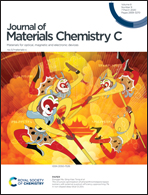Photoactuators based on the dynamic molecular crystals of naphthalene acrylic acids driven by stereospecific [2+2] cycloaddition reactions†
Abstract
The photomechanical effects of the dynamic molecular crystals of halogen-substituted naphthalene acrylic acids (1FNaAA, 1ClNaAA, 1BrNaAA, 1INaAA and 6BrNaAA) have been investigated. Upon UV irradiation, the needle-like crystal of 1FNaAA curls away from the light source, while the slice-like crystal of 6BrNaAA bends towards the light source. Moreover, the light-induced bending, flipping and bursting are observed for the elongated needle-like crystals of 1FNaAA, and the slice-like crystals of 1ClNaAA and 1BrNaAA show bending, cracking, coiling, rotating and twisting triggered by 365 nm light. It is found that stereospecific [2+2] cycloaddition reactions take place in the crystals to afford one stereoisomer of β-type cyclobutanes, since 1FNaAA, 1ClNaAA, 1BrNaAA and 6BrNaAA pack in a head-to-head mode, which satisfies the Schmidt's topo-photochemical criteria. The strain can be generated and accumulated during the photodimerization, and the release of the strain leads to the photomechanical effects. This provides new clues for the development of photomechanical molecular crystals based on acrylic acids bearing halogen-substituted aromatic units.
![Graphical abstract: Photoactuators based on the dynamic molecular crystals of naphthalene acrylic acids driven by stereospecific [2+2] cycloaddition reactions](/en/Image/Get?imageInfo.ImageType=GA&imageInfo.ImageIdentifier.ManuscriptID=C9TC06689F&imageInfo.ImageIdentifier.Year=2020)


 Please wait while we load your content...
Please wait while we load your content...